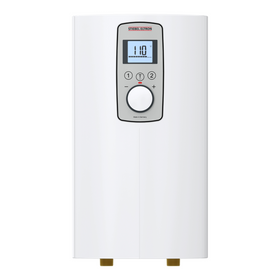
Flood Risks and Home Resilience: An In-Depth Interview
Last Updated: Mar 29, 2025Weather events — drought, flood, fire, extreme heat, windstorms — are more powerful, more frequent, and do more damage to homes and communities today than they did in the past. The costliest culprit is flooding. "When it comes to climate change and expressions of extreme weather risk, the most expensive and the event that wreaks the most havoc is water," says Blair Feltmate, head of the Intact Centre on Climate Adaptation at the University of Waterloo in Ontario, Canada.
While builders and architects work on developing more resilient residential structures for the future, there are things — simple things — that current homeowners can do to mitigate flood risks, Feltmate says.
Table of Contents
- Are There Different Types of Floods?
- Does Global Warming Increase Flooding?
- What Else Is Causing Increased Flooding?
- High Flood Risks and Home Purchasing
- Dated Flood Maps
- Is Flood Damage Expensive?
- Flood Mitigation Efforts
- Climate Risk Mitigation
- What Can Homeowners Do to Mitigate Flooding?
- Should Homeowners Assess Flood Risks Before Buying a Home?
Are There Different Types of Floods?
There are two types of floods, flash floods and river floods. Flash floods, also called "pluvial floods," occur when there's excessive rainfall, which increases surface water and causes flooding independent of a river overflowing. A pluvial flood can happen in an area that is not anywhere near a body of water. River floods also called "fluvial floods," occur when water in a lake, stream, or river overflows its banks and shorelines.

Does Global Warming Increase Flooding?
Global warming has led to sea-level rise, more extreme weather, and storm intensity, which can exacerbate all types of flooding. "The amount of water that comes down during a big downpour – the top 1% of precipitation events – over the last 70 years toward the western end of the Great Lakes, has increased by 37%; toward the eastern end the intensity has increased by 71%. If you have the perception that storms occurring today are more intense than in the past, you're right, and it's borne out by data," Feltmate says.
What Else Is Causing Increased Flooding?
Feltmate cites other causes of increased flooding, including the loss of natural infrastructure, aging municipalities, and housing infrastructure.
High Flood Risks and Home Purchasing
Why, despite this knowledge, do people continue to build and purchase homes in flood zones? First Street Foundation, a non-profit research group based in New York, estimated that almost 15 million properties are located in the hundred-year flood zone.
Homeowners will purchase flood insurance to live in areas that are at risk for flooding. Often, it's under the misguided idea that if there hasn't been a flood for a long time, it won't happen any time soon. "People have to understand that because of climate change, the weather of the past is not a predictor of the weather of the future," Feltmate says.
In Canada, there are approx. 500,000 to 800,000 high flood risk homes, often on the edge of flowing water systems, Feltmate says. "Although some of those properties might be protected through the deployment of community-level flood mitigation, the cost to protect many would be over anything considered reasonable. Offering those people a one-time payment to move out and relocate — well, most people are not anxious to do that. And, almost always, the amount of money offered is less than homeowners think their property is worth. If they don't take the compensation, they're generally on their own from now on."
Sometimes, local leaders don't want to declare land off-limits for new builds because they don't want to lose tax revenue. Developers don't want to learn late because land previously purchased is now considered a flood zone.

Dated Flood Maps
In addition, construction guidelines depend on up-to-date flood plain maps, and "in Canada, flood risk maps are generally about 20 to 25 years out of date," Feltmate says. "We need maps that will show where the water will go during a flood today, and 25 years from now."
The same is true for the United States. A 2020 report from the Association of State Floodplain Managers concluded that the federal government needs to spend nearly $12 billion to improve the nation's flood maps. According to the report, only about one-third of the rivers and streams have flood hazard information. There are 2.3 million miles of streams unmapped for flooding hazards. The Federal Emergency Management Association uses these maps to decide which properties require flood insurance. And, without up-to-date information, builders will continue to build in risky areas.

Is Flood Damage Expensive?
Reuters reported that the cost of flood damage on homes in the United States was approximately $17 billion annually between 2010 and 2018. According to a First Street Foundation report, that figure is expected to rise to $32 billion by 2051. If Canadians do nothing to prevent flood damage, by 2030, they can expect to pay $6.6 billion (US).
When it comes to flooding, the number one cost for homeowners is basement damage. "In Canada, insurance premiums have risen 20% to 25% over the past five years," Feltmate says. "And 60% of that increase is due to flooding. For 11 of the past 12 years, the insurance industry has paid out more than $1 billion a year."
FEMA's National Flood Insurance Program provides most, but not all, flood insurance in the United States. Homeowner flood insurance costs vary by state, with the costliest being Connecticut ($1,395/year) and Florida, the least expensive ($550/year).
In Canada, overland flood insurance only became available in 2015 – this is coverage for water entering a basement generally through a ground-level window or down a stairwell following a major storm. Despite the recent availability of overland flood insurance, only about 30 percent of homeowners have purchased this coverage. A choice that many end up lamenting following increasingly common overland flooding, according to Feltmate.

Flood Mitigation Efforts
On the big picture side, governments and municipalities need to address climate change. "It is here to stay, and we'll have floods, drought, hail, wind, snow load, sea-level rise, permafrost loss, lots of things going wrong in terms of extreme weather events," Feltmate says. There are three ways to address climate change: "mitigate greenhouse gas emissions, generally through a carbon tax or cap-and-trade system; capture and sequester carbon, and adapt to the extreme risk."
Water Saving
Shop home improvement products that help save and conserve water.

Stiebel Eltron Accelera 300 E Heat Pump Water Heater
Stiebel Eltron
Out of Stock

Stiebel Eltron DHC-E 8/10-2 Plus Point-of-Use Electric Tankless Water Heater - 202145
Stiebel Eltron
In Stock

Stiebel Eltron Accelera 220 E Heat Pump Water Heater
Stiebel Eltron
In Stock

Stiebel Eltron DHC-E 3/3.5-1 Trend Point-of-Use Electric Tankless Water Heater - 200057
Stiebel Eltron
In Stock

Stiebel Eltron DHC-E 12/15-2 Plus Point-of-Use Electric Tankless Water Heater - 200056
Stiebel Eltron
In Stock

Stiebel Eltron Mini 2-1 Single Handwashing Sink Electric Tankless Water Heater
Stiebel Eltron
In Stock

Stiebel Eltron Tempra 24 Whole House 24 kW 5 GPM Electric Tankless Water Heater
Stiebel Eltron
In Stock

Stiebel Eltron DHC-E 8/10 - 2 Trend Point-of-Use Electric Tankless Water Heater - 200058
Stiebel Eltron
In Stock

Stiebel Eltron DHC-E 4/6.2 - 2 Trend Point-of-Use Electric Tankless Water Heater - 200061
Stiebel Eltron
In Stock

Saniflo Sanibest Pro Combo Macerator System
Saniflo
In Stock

Climate Risk Mitigation
There also are things individuals can do to mitigate the effects of climate change. Feltmate's Intact Centre has developed standards and guidelines that focus on flood risk. The organization looks at coastline resiliency to new and existing community design to what can be done at the individual homeowner level.
The center suggests ways to direct water to safe locations using berms, diversion channels, and permeable surfacing at the community level at the community level. But, Feltmate says, the greatest immediate flood risk protection potential resides with "helping homeowners to help themselves. This is the highly solvable level. It's shocking the things you can do around the home on a long weekend, around the outside of the property and in the basement itself to greatly limit flood risk, generally for less than a few hundred dollars."

What Can Homeowners Do to Mitigate Flooding?
Homeowners can mitigate flooding at home in many ways. For example, they can remove debris from the nearest storm drain or ditch, extend downspouts and sump discharge pipes at least two meters / six yards from the foundation, or they could install a backup sump pump and battery.
Feltmate suggests testing your sump pump to ensure it's working, which many people don't do. "The first time they find out their sump pump has seized is after a catastrophic event. But testing is as simple as dumping a bucket of water in it."
He also says to clean the seal on the backwater valve found (if you have one), which in turn stops water from surging into the basement from storm sewers during major downpours – "it only takes five to ten minutes in the spring and fall." And, simplest of all, put plastic covers over window wells at ground level.

Should Homeowners Assess Flood Risks Before Buying a Home?
Feltmate outlines these steps:
- Ask your home inspector if they've taken training in-home flood risk assessment and whether a flood risk assessment factors into the home inspection.
- Ask locals about flooding history
- Find out if the home within or outside of the flood plain based on the most up-to-date flood plain maps available
- If the house is more than 15 years old (which suggests sanitary and storm sewer lines may be linked), find out whether it has a backwater valve
- Check for a sump pump with battery backup
- Make sure there are plastic covers over grade level windows
While the Intact Centre is educating homeowners, it also has a training program for professional accreditation on climate change and home flood protection. Real estate agents, brokers, mortgage lenders, insurance brokers, and home inspectors are taking the five-part course. Feltmate believes individuals can make a difference and don't always have to wait for government intervention.
No matter how you slice the equation, not having flooded basements is good for everyone – homeowners, insurers, municipalities, and at the state and federal level. Everybody wins. The issue is not that we don't know what to do; it's that we're not doing it aggressively enough.
Stacey Freed
I’m constantly on the hunt for a way to hike and write simultaneously.
